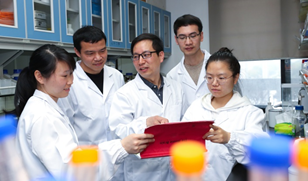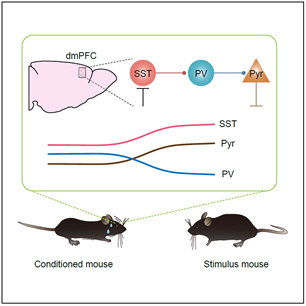A research team led by Han Xu, a professor of neurobiology at Zhejiang University School of Medicine has uncovered a previously unknown neuronal circuitry that mediates social fear behavior. The research is entitled “A Disinhibitory Microcircuit Mediates Conditioned Social Fear in the Prefrontal Cortex” and published online in Neuron on March 18th. Professor Han Xu is the corresponding author of this article. Graduate students Haifeng Xu, Ling Liu, Yuanyuan Tian, and Dr. Jun Wang are co-first authors. Prof. Shumin Duan from Zhejiang University, Prof. Tian-Le Xu from Shanghai Jiao Tong University School of Medicine and Prof. Miao He from Fudan University are co-authors of the article.

Members of Dr. Han Xu’s group
Social anxiety disorder (SAD), also referred to as social phobia, is a prevalent and disabling disorder characterized by social fear and avoidance of social situations. Despite its prevalence and disabling consequences, the underlying neurobiology of SAD remained largely unknown, and there are no satisfactory therapeutic options available. Prof. Xu’s research team has uncovered a novel disinhibitory microcircuit in prefrontal cortex and suggested that this circuitry plays an important role in gating social fear behavior.
Animal Model of SAD Induced by Social Fear Conditioning
To study the neural mechanism underlying social fear precisely, it is crucial to develop specific animal model. In this research, the researchers adopted a social fear conditioning paradigm in mice, by pairing social exploration to an unfamiliar stimulus mouse with an electric foot shock. After conditioning, the experimental mouse developed robust and long-lasting social fear to conspecifics of either gender, but not to nonsocial stimulus such as a novel object. Therefore, it represents an appropriate animal paradigm to study the neural basis underlying social fear.

Prefrontal Neural Mechanism Underlying Social Fear
Recent evidence from both human and animal studies has implicated the prefrontal cortex (PFC) in the processes of fear regulation. In this study, the authors found that the social fear behaviors were reduced after inactivation of dorsomedial PFC (dmPFC) neuronal activities by GABAa receptor agonist muscimol, indicating that dmPFC plays a crucial role in gating social fear expression.
Normal brain functions rely on a delicate balance between excitation and inhibition. To perform its complex operations, the mammalian cerebral cortex has evolved a large diversity of GABAergic INs based on differences in neuronal morphologies, electrophysiological properties and neurochemical markers. Combining multiple-channel electrophysiological recordings with opto-tagging of distinct type of neurons, they further revealed that parvalbumin (PV) INs firing rate was significantly suppressed during social fear expression. Indeed, the reduction in PV firing is responsible for the elevation of principle neurons’ firing and hence the social fear since either activation of PV INs or inactivation of pyramidal cells largely reversed fear behavior. More importantly, as compared to naïve mice, activity of SST INs of conditioned mice dramatically increased when the conditioned mouse confronted with a conspecific. They further demonstrated that it is SST INs that inhibited PV INs and disinhibited pyramidal cells and consequently enhanced dmPFC output to mediate social fear responses.
Prefrontal disinhibitory microcircuit underlying social fear
This research was supported by grants from the National Key R&D Program of China, the National Natural Science Foundation of China, the Zhejiang Provincial Natural Science Foundation of China, the Chinese Ministry of Education Project 111 Program, and the Non-profit Central Research Institute Fund of Chinese Academy of Medical Sciences.
Professor Han Xu
Professor Han Xu pursued his Ph.D. in neuroscience at University of Science and Technology of China. Then, he conducted postdoctoral research at New York University, where he spent nine years studying the development and function of cortical circuits and made important findings (Neuron, 2013; J Neurosci. 2007; 2010; 2012). Dr. Xu was a recipient of postdoctoral scholarship from the International Rett Syndrome Foundation. In 2014, he was appointed as a full-professor of Neurobiology at Zhejiang University School of Medicine. His laboratory focuses on neuronal circuits underlying social interaction behavior and social deficits associated with neuropsychiatric disorders including anxiety, depression